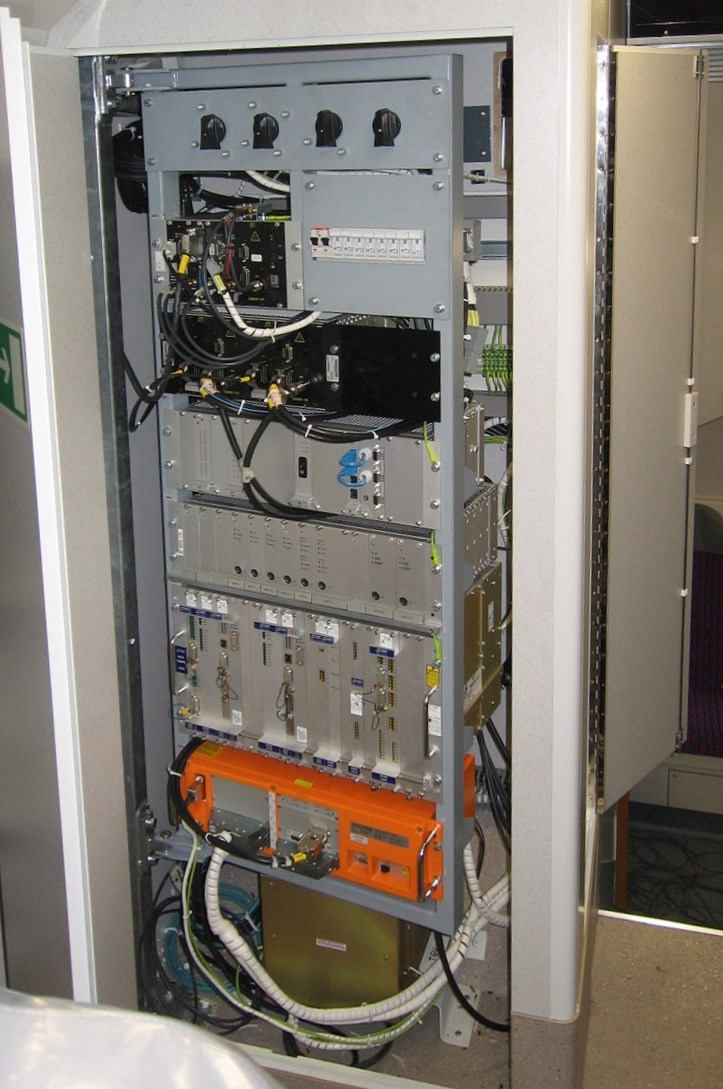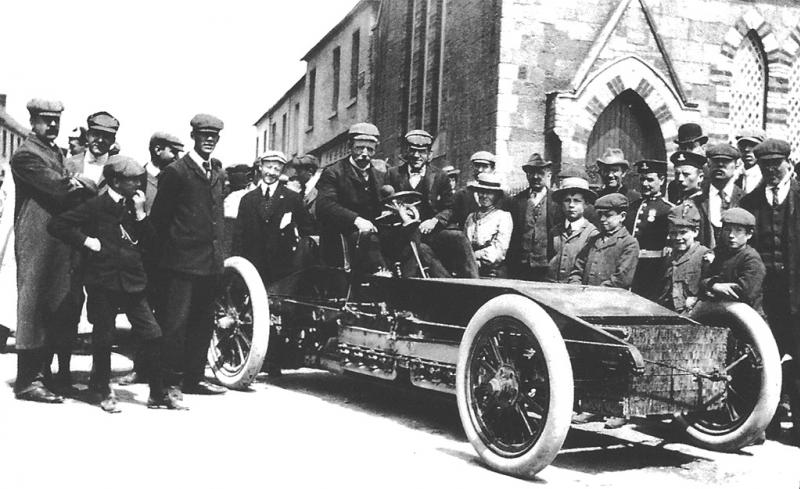|
1853 Straffan Rail Accident
The Straffan Rail Disaster occurred on 5 October 1853, when a goods train ran into the back of a stationary passenger train south of Straffan station in County Kildare. Background The Great Southern and Western Railway line from Dublin to Cork had only been in operation six years when 18 people died in what is still Ireland's third-worst railway tragedy, having only been surpassed by the Armagh rail disaster of 1889 (80 killed) and the Ballymacarrett rail crash of 1945 (23 killed). Events At 6:20 pm on 5 October 1853, the piston rod on a locomotive snapped, stranding the newly introduced noon express train from Cork south of Straffan Station, towards Baronrath, in a dense fog and gathering twilight. There were a total of 45 passengers in the two first- and three second-class carriages. Edward Croker Barrington, a solicitor for the company, who was a passenger on the train, directed the fireman, John O'Hara, to signal a warning to a 20-wagon goods train which had been passed i ... [...More Info...] [...Related Items...] OR: [Wikipedia] [Google] [Baidu] |
Straffan
Straffan (variously ''Teach Srafáin'', ''Strafáin'' or ''An Cluanini'' in Irish) is a village in County Kildare, Ireland, situated on the banks of the River Liffey, 25 km upstream of the Irish capital Dublin. As of the 2016 census, the village had a population of 853, a nearly two-fold increase (from 439) since the 2006 census. Straffan is the name of the surrounding electoral division which is within the ''Celbridge Number 1 Rural Area'', and which (as of 2006) had a population of 1,449. At one time a separate parish, it is today joined to the parishes of Celbridge (in the Roman Catholic structure) and ''Celbridge and Newcastle'' (Church of Ireland), in the respective Dublin dioceses. Straffan is home to the ''Kildare Country Club'', commonly known as the K Club, and its two championship golf courses, which have staged major international events such as the European Open (hosted annually there between 1995-2007), and the Ryder Cup tournament between Europe and the USA i ... [...More Info...] [...Related Items...] OR: [Wikipedia] [Google] [Baidu] |
Train Event Recorder
A train event recorder – also called On-Train Monitoring Recorder (OTMR), On-Train Data Recorder (OTDR), Event Recorder System (ERS), Event Recorder Unit (ERU), or simply Event Recorder (ER) – is a device that records data about the operation of train controls, the performance of the train in response to those controls, and the operation of other train control systems. It is similar to the flight data recorder found on aircraft. Functions Because event recorders are integrated with most car-borne systems, they are an attractive target for enhanced diagnostic and control functions. Some event recorders feature outputs controlling penalty braking or emergency braking systems, as well as speedometers. Data storage can be provided by magnetic tape, battery-backed RAM and, more recently, non-volatile EEPROM or flash memory, overwritten in a FIFO continuous loop. The data is intended for use in the investigation of accidents and other incidents, but is also used to monitor ... [...More Info...] [...Related Items...] OR: [Wikipedia] [Google] [Baidu] |
October 1853 Events
October is the tenth month of the year in the Julian and Gregorian calendars and the sixth of seven months to have a length of 31 days. The eighth month in the old calendar of Romulus , October retained its name (from Latin and Greek ''ôctō'' meaning "eight") after January and February were inserted into the calendar that had originally been created by the Romans. In Ancient Rome, one of three Mundus patet would take place on October 5, Meditrinalia October 11, Augustalia on October 12, October Horse on October 15, and Armilustrium on October 19. These dates do not correspond to the modern Gregorian calendar. Among the Anglo-Saxons, it was known as Winterfylleth (Ƿinterfylleþ), because at this full moon, winter was supposed to begin. October is commonly associated with the season of spring in parts of the Southern Hemisphere, and autumn in parts of the Northern Hemisphere, where it is the seasonal equivalent to April in the Southern Hemisphere and vice versa. October ... [...More Info...] [...Related Items...] OR: [Wikipedia] [Google] [Baidu] |
Accidents And Incidents Involving Great Southern And Western Railway
An accident is an unintended, normally unwanted event that was not directly caused by humans. The term ''accident'' implies that nobody should be blamed, but the event may have been caused by unrecognized or unaddressed risks. Most researchers who study unintentional injury avoid using the term ''accident'' and focus on factors that increase risk of severe injury and that reduce injury incidence and severity. For example, when a tree falls down during a wind storm, its fall may not have been caused by humans, but the tree's type, size, health, location, or improper maintenance may have contributed to the result. Most car wrecks are not true accidents; however English speakers started using that word in the mid-20th century as a result of media manipulation by the US automobile industry. Types Physical and non-physical Physical examples of accidents include unintended motor vehicle collisions, falls, being injured by touching something sharp or hot, or bumping into somet ... [...More Info...] [...Related Items...] OR: [Wikipedia] [Google] [Baidu] |
1853 In Ireland
Events from the year 1853 in Ireland. Events *15 February – City of Dublin Steam Packet Company , inward bound from Liverpool, sinks in a snowstorm at night below Baily Lighthouse on Howth Head with the loss of more than 80 lives. *12 May–31 October – Great Industrial Exhibition (1853), Great Industrial Exhibition held in Dublin, promoted by William Dargan. Queen Victoria, accompanied by the Albert, Prince Consort, Prince Consort and the Edward VII, Prince of Wales, pays an official visit on 29 August. John Hutton & Son of Dublin exhibit the Irish State Coach. Births *30 January – Leland Hone, cricketer (died 1896 in Ireland, 1896). *6 February – Robert John McConnell, businessman, baronet and Lord Mayor of Belfast (died 1927 in Northern Ireland, 1927). *7 February – Egerton Bushe Coghill, painter (died 1921 in Ireland, 1921). *30 March – Frank O'Meara, artist (died 1888 in Ireland, 1888). *March – John Doogan, soldier, recipient of the Victoria Cross for gallant ... [...More Info...] [...Related Items...] OR: [Wikipedia] [Google] [Baidu] |
History Of County Kildare
County Kildare in the province of Leinster, Ireland, was first defined as a diocese in 1111, shired in 1297 and assumed its present borders in 1836. Its location in the Liffey basin on the main routes from Dublin to the south and west meant it was a valuable possession and important theatre of events throughout Irish history. Ancient history An inland town on Ptolemy's map of Ireland of 100 AD may be Rheban on the Barrow river, the only written records from pre-Christian County Kildare. The estimated date for the abandonment of the sacred pre-Christian site of Knockaulin/ Dún Áilinne is 400 AD, the traditional date for foundation of the monastery at Cill Dara is 490 AD, the date for the death of first Bishop Conlaed ua hEimri, (St Conleth) is 520 AD and the estimated date for the death of foundress Saint Brigit, St Brigid (Irish: Naomh Bríd), is 524 AD (also dated 521 and 526). Her death has been celebrated traditionally on 1 February, which is also the pre-Christian festival ... [...More Info...] [...Related Items...] OR: [Wikipedia] [Google] [Baidu] |
Transport In County Kildare
Transport (in British English), or transportation (in American English), is the intentional movement of humans, animals, and goods from one location to another. Modes of transport include air, land ( rail and road), water, cable, pipeline, and space. The field can be divided into infrastructure, vehicles, and operations. Transport enables human trade, which is essential for the development of civilizations. Transport infrastructure consists of both fixed installations, including roads, railways, airways, waterways, canals, and pipelines, and terminals such as airports, railway stations, bus stations, warehouses, trucking terminals, refueling depots (including fueling docks and fuel stations), and seaports. Terminals may be used both for interchange of passengers and cargo and for maintenance. Means of transport are any of the different kinds of transport facilities used to carry people or cargo. They may include vehicles, riding animals, and pack animals. Vehicles may ... [...More Info...] [...Related Items...] OR: [Wikipedia] [Google] [Baidu] |
Railway Accidents Involving Fog
Rail transport (also known as train transport) is a means of transport that transfers passengers and goods on wheeled vehicles running on rails, which are incorporated in Track (rail transport), tracks. In contrast to road transport, where the vehicles run on a prepared flat surface, rail vehicles (rolling stock) are directionally guided by the tracks on which they run. Tracks usually consist of steel rails, installed on Railroad tie, sleepers (ties) set in track ballast, ballast, on which the rolling stock, usually fitted with metal wheels, moves. Other variations are also possible, such as "slab track", in which the rails are fastened to a concrete foundation resting on a prepared subsurface. Rolling stock in a rail transport system generally encounters lower friction, frictional resistance than rubber-tyred road vehicles, so passenger and freight cars (carriages and wagons) can be coupled into longer trains. The rail transport operations, operation is carried out by a ... [...More Info...] [...Related Items...] OR: [Wikipedia] [Google] [Baidu] |
Train Collisions In The Republic Of Ireland
In rail transport, a train (from Old French , from Latin , "to pull, to draw") is a series of connected vehicles that run along a railway track and transport people or freight. Trains are typically pulled or pushed by locomotives (often known simply as "engines"), though some are self-propelled, such as multiple units. Passengers and cargo are carried in railroad cars, also known as wagons. Trains are designed to a certain gauge, or distance between rails. Most trains operate on steel tracks with steel wheels, the low friction of which makes them more efficient than other forms of transport. Trains have their roots in wagonways, which used railway tracks and were powered by horses or pulled by cables. Following the invention of the steam locomotive in the United Kingdom in 1804, trains rapidly spread around the world, allowing freight and passengers to move over land faster and cheaper than ever possible before. Rapid transit and trams were first built in the late 1800s t ... [...More Info...] [...Related Items...] OR: [Wikipedia] [Google] [Baidu] |





.jpg)